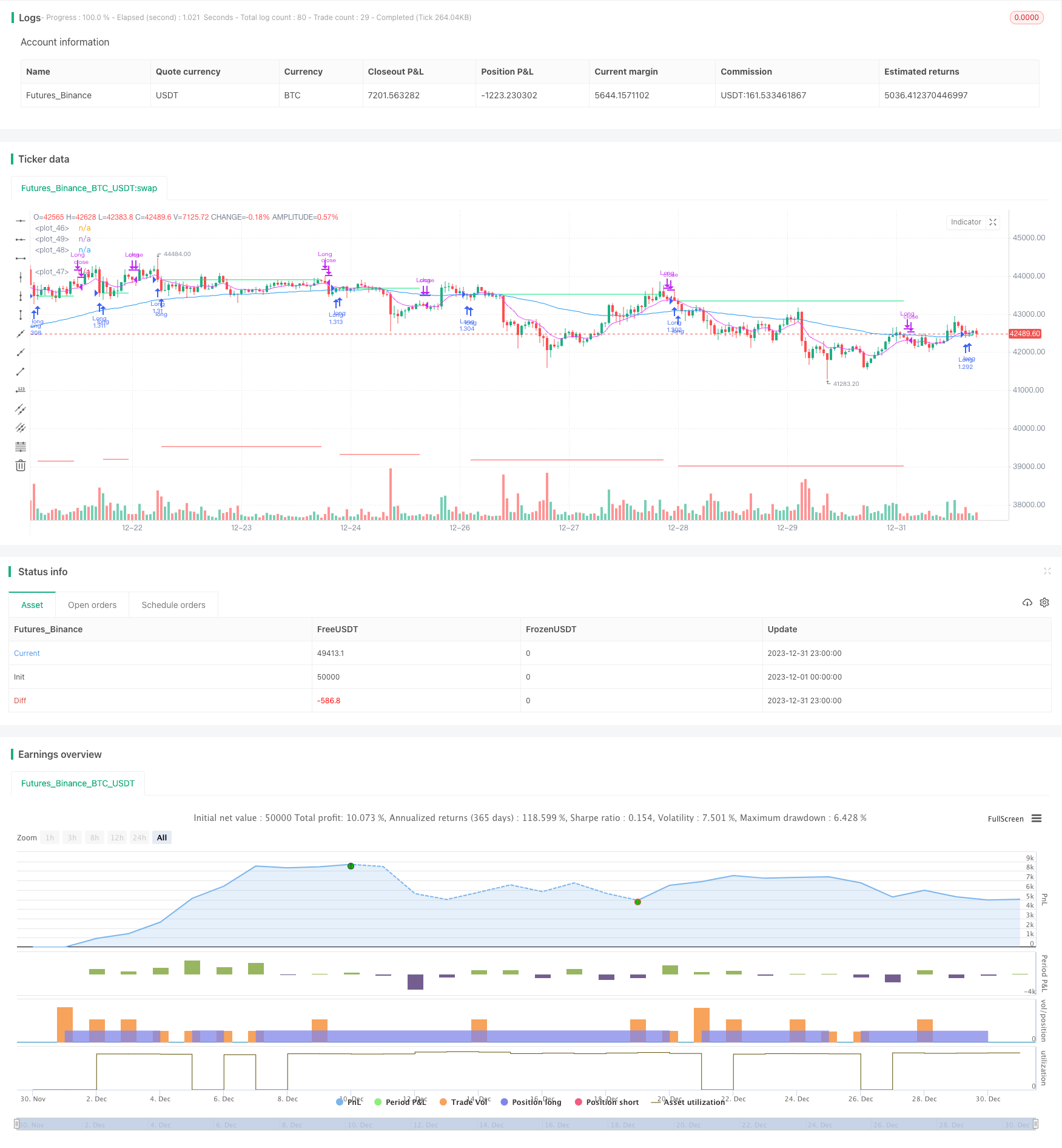
概述 Overview
EintSimple Pullback Strategy是一个基于双移动平均线交叉的回调入场策略。该策略首先使用长期和短期两个移动平均线,当短期移动平均线从下方突破长期移动平均线时生成买入信号。为了过滤假突破,该策略还要求收盘价高于长期移动平均线。
在入场后,如果价格重新跌破短期移动平均线,则btc体现退出信号。此外,该策略还设置了离场止损,如果从最高点回撤幅度达到设置的止损百分比,也会退出仓位。
策略原理 Strategy Logic
该策略主要基于双移动平均线的黄金交叉来判断入场时机。具体来说,需同时满足以下条件才会开仓做多:
- 收盘价大于长期移动平均线ma1
- 收盘价低于短期移动平均线ma2
- 目前没有持仓
满足上述条件后,该策略会全仓做多。
退出信号判断基于两个条件,一个是价格重新跌破短期移动平均线,另一个是从最高点回撤幅度达到设置的止损百分比。具体退出条件如下:
- 收盘价大于短期移动平均线ma2
- 从最高点回撤幅度达到设置的止损百分比
满足任一退出条件时,该策略会平掉全部多单。
优势分析 Advantages
使用双移动平均线交叉并结合实体收盘价格判断,可以有效过滤假突破。
采用回调入场,可以在股价形成短期拐点之后进入。
有止损设定,可以限制最大回撤。
风险分析 Risks
双移动平均线交叉策略容易产生多次交易信号,可能追高杀跌。
移动平均线参数设置不当可能导致曲线过于光滑或过于敏感。
止损设置过于宽松会让亏损扩大。
优化方向 Optimization
测试不同长度的长短期移动平均线参数组合,找到最优参数。
比较测试使用收盘价和典型价格判断移动平均线交叉的效果。
测试添加交易量或波动性指标等过滤器。
对止损幅度进行回测优化,找到最佳设置。
总结 Conclusion
EintSimple Pullback Strategy是一个简单实用的双移动平均线回调策略。它有效利用了移动平均线的指示功能,同时结合实体收盘价格判断来过滤假信号。虽然该策略容易产生频繁交易和追高杀跌的问题,但是通过参数优化和添加过滤器可以进一步完善。总的来说,该策略是一个非常适合量化交易初学者实践和优化的策略。
策略源码
/*backtest
start: 2023-12-01 00:00:00
end: 2023-12-31 23:59:59
period: 1h
basePeriod: 15m
exchanges: [{"eid":"Futures_Binance","currency":"BTC_USDT"}]
*/
// This source code is subject to the terms of the Mozilla Public License 2.0 at https://mozilla.org/MPL/2.0/
// © ZenAndTheArtOfTrading / www.PineScriptMastery.com
// @version=5
strategy("Simple Pullback Strategy",
overlay=true,
initial_capital=50000,
default_qty_type=strategy.percent_of_equity,
default_qty_value=100)// 100% of balance invested on each trade
// Get user input
i_ma1 = input.int(title="MA 1 Length", defval=75, step=1, group="Strategy Parameters", tooltip="Long-term EMA")
i_ma2 = input.int(title="MA 2 Length", defval=9, step=1, group="Strategy Parameters", tooltip="Short-term EMA")
i_stopPercent = input.float(title="Stop Loss Percent", defval=0.10, step=0.1, group="Strategy Parameters", tooltip="Failsafe Stop Loss Percent Decline")
i_lowerClose = input.bool(title="Exit On Lower Close", defval=true, group="Strategy Parameters", tooltip="Wait for a lower-close before exiting above MA2")
i_startTime = input(title="Start Filter", defval=timestamp("01 Jan 1995 13:30 +0000"), group="Time Filter", tooltip="Start date & time to begin searching for setups")
i_endTime = input(title="End Filter", defval=timestamp("1 Jan 2099 19:30 +0000"), group="Time Filter", tooltip="End date & time to stop searching for setups")
// Get indicator values
ma1 = ta.ema(close, i_ma1)
ma2 = ta.ema(close, i_ma2)
// Check filter(s)
f_dateFilter = true
// Check buy/sell conditions
var float buyPrice = 0
buyCondition = close > ma1 and close < ma2 and strategy.position_size == 0 and f_dateFilter
sellCondition = close > ma2 and strategy.position_size > 0 and (not i_lowerClose or close < low[1])
stopDistance = strategy.position_size > 0 ? ((buyPrice - close) / close) : na
stopPrice = strategy.position_size > 0 ? buyPrice - (buyPrice * i_stopPercent) : na
stopCondition = strategy.position_size > 0 and stopDistance > i_stopPercent
// Enter positions
if buyCondition
strategy.entry(id="Long", direction=strategy.long)
if buyCondition[1]
buyPrice := open
// Exit positions
if sellCondition or stopCondition
strategy.close(id="Long", comment="Exit" + (stopCondition ? "SL=true" : ""))
buyPrice := na
// Draw pretty colors
plot(buyPrice, color=color.lime, style=plot.style_linebr)
plot(stopPrice, color=color.red, style=plot.style_linebr, offset=-1)
plot(ma1, color=color.blue)
plot(ma2, color=color.fuchsia)